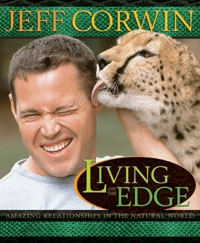Adventures in High-Def Page 2
Do animals look better in high def? Everything looks better except when I can see a pimple. A blemish that appears to be a little bump on your skin looks like a cherry pie. It's also a learning process for me because the lenses are so wide that the camera can come really close and still keep me in the frame. I'm used to working in the typical [4:3] format. I'll think I'm off camera when I walk away, but then they say, "Keep walking." 
The amazing part is that I can be sitting still and say, "Look over there," and the camera doesn't have to sweep. Since everything is already right there in the picture, your eyes can pan toward what I'm talking about. The camera doesn't have to choose between focusing on what I'm talking about and my perspective as the storyteller. This new way to frame the picture is pretty unbelievable. And it's so clean looking. We just did a show on anacondas, and it's amazing when you look at it - there's a vast landscape and you can see this 15-foot, 250-pound snake within it.
But how do you frame a giraffe? You just take the camera and go like this [mimes a frame being turned on its side]. Of course, if the giraffe is sitting down, no problem! It's exciting to be one of the first TV shows doing this. And we're ideal for HDTV because we show the vibrancy of colors in the wild. We've got location, color, culture, wildlife. And that's what high-definition is all about. Compared with regular TV, this really is night and day.
Why won't CBS risk taking high-def cameras into the wilderness for Survivor, but you guys do it? It's very expensive. The production company I work with is making a huge investment. We just lost a camera - luckily, it wasn't a high-def camera. A field producer fell into a ditch in Venezuela filled with about 8 feet of water. That was a $5,000 camera, but if a high-def camera sinks, that's $200,000. By upgrading to HDTV, we lost the use of a second camera because it's just too expensive. When high-def cameras come down in price, and we can go back to being a two-camera show, boy, life will be easier.
Do you own an HDTV? I don't have a TV right now. My wife and I are homeless as we remodel our house, but I'm getting this awesome big HDTV. I don't know who makes it, but it just came out. Since I live on an island off Massachusetts, the only way I can receive an HDTV signal is by satellite.
So how does a bat biologist get into show business? I was intrigued by the challenge of using TV not only to entertain but to enlighten. I want to take information about conservation, natural history, and ecology, and present it in a way that's fun. It's not about firing information at people, but about them absorbing that information and having a pleasurable, exciting time. I try to infuse humor and all sorts of things into it. And I imagine the audience being my adventure companion. I'm looking at the camera and imagining someone sitting there, and I'm speaking to them personally. We're buddies on the road having fun.
During graduate school I realized that I didn't want to do long-term research or be a specialist. I was a generalist - a naturalist. A naturalist's job is to take information and present it so people will be able to understand the world around them. Today, that is so important because our resources are in jeopardy. Instead of using a lecture hall, I use television. But ultimately TV isn't about education - it's about entertainment. You might have important information to share, but if people don't enjoy watching you, then you're not going to be on TV.
What do you do when you're not working on the show?  I've got a book coming out in November from Rodale called Living on the Edge: Amazing Relationships in the Natural World. In it I highlight four of my favorite places in the world, including a watering hole in Tanzania and the Sonora Desert in Arizona. It's all about how creatures come together to define an ecosystem. It's 80,000 words, which I'm writing myself, plus pictures that I took with a good 35mm camera.
I've got a book coming out in November from Rodale called Living on the Edge: Amazing Relationships in the Natural World. In it I highlight four of my favorite places in the world, including a watering hole in Tanzania and the Sonora Desert in Arizona. It's all about how creatures come together to define an ecosystem. It's 80,000 words, which I'm writing myself, plus pictures that I took with a good 35mm camera.
You're talking high-def again. What are some of your favorite photographs? I have shots like an anaconda swallowing a lizard and African pelicans taking a mud bath at sunset. Out of thousands of pictures, I've selected a couple hundred. The publisher will select about 60 to 80 pictures for the book. I've basically modeled the story around these pictures, but it's not a coffee-table book - it's a real book.
























































